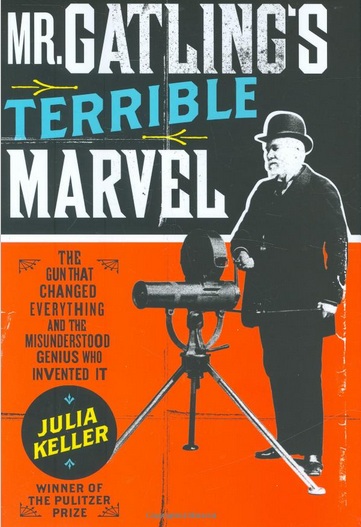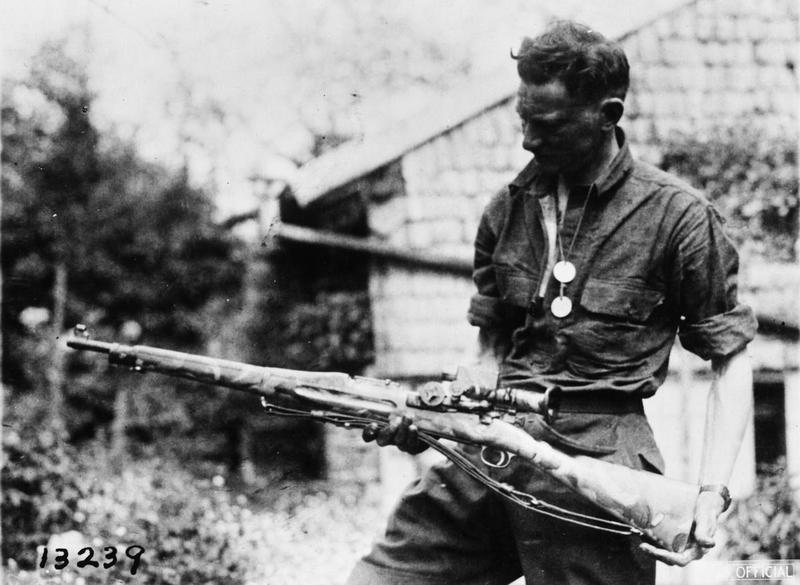 I hate to perpetuate stereotypes, but this is a case where there is more than a kernel of truth to one. The unfortunate subject is Julia Keller, author of Mr. Gatling’s Terrible Marvel, and she is very much an outsider to the world of firearms. She is a journalist, and one with an impressive list of qualifications: a Master’s in English Literature. Teaching positions at Harvard, Notre Dame, and the University of Chicago. A Pulitzer Prize, earned for a Chicago Tribune story on a deadly 2004 tornado in Utica, IL. A long-time position as Culture Critic for the Chicago Tribune. Does any of this sounds like a person ripe to research a new and groundbreaking study of Richard Gatling and his iconic gun? Yeah, I didn’t think so either (although she would be top of my list if I wanted to fill an academic position in an ivory tower university).
I hate to perpetuate stereotypes, but this is a case where there is more than a kernel of truth to one. The unfortunate subject is Julia Keller, author of Mr. Gatling’s Terrible Marvel, and she is very much an outsider to the world of firearms. She is a journalist, and one with an impressive list of qualifications: a Master’s in English Literature. Teaching positions at Harvard, Notre Dame, and the University of Chicago. A Pulitzer Prize, earned for a Chicago Tribune story on a deadly 2004 tornado in Utica, IL. A long-time position as Culture Critic for the Chicago Tribune. Does any of this sounds like a person ripe to research a new and groundbreaking study of Richard Gatling and his iconic gun? Yeah, I didn’t think so either (although she would be top of my list if I wanted to fill an academic position in an ivory tower university).
Ms. Keller’s book is not, in fact, a history of Gatling and the Gatling Gun at all, although you’ll be forgiven for thinking so, considering the subtitle “The gun that changed everything and the misunderstood genius who invented it.” Had I thought to look past the cool photo of Gatling on the cover before diving into the text, I would have gotten a whiff of the problems to come.
As many folks who read this site will realize, the Gatling really didn’t change very much at all. It was arguably the best of the manually-operated machine guns, but it had no impact on the Civil War and was out of service by WWI. It saw use only in the brush wars of the late 1800s, in the American west and Africa. One could say the Maxim changed everything, but not the Gatling. And this leads us to the second half of that hyperbolic subtitle – misunderstood genius? Not really. Not to belittle him, but Gatling was a pretty straight-forward figure. He was an inveterate inventor and tinkerer, and close to an archetypical figure of American culture at the time. He didn’t really have any dark secrets or shameful habits. He was lovingly devoted to his family, intellectually curious and active, and an able (if not outstanding) businessman.
Unfortunately, Keller decided to ignore facts that might point in the wrong direction, and attempt to mold Gatling into a central pillar about which to write a cultural critique of 19th century America. That is the true subject of the book – a social and cultural history of the late 1800s with a garnishing of flowery prose.
That doesn’t leave the work without merit, although Keller’s personal attitude towards gun as icky detestable things is annoying when it shines through. Many of the side issues she discusses – such as the history of the US Patent Office and the nature of steamship travel – were quite interesting, and introduced me to things I hadn’t known. After reading the cover, though, one is tempted to flip right past those pages, looking for non-existent information on, you know, the Gatling Gun. On the bright side, by not including any technical information she also manages to not get any of it wrong, which is something.
To be fair, the problems with the book are largely based in the expectations one gets from the cover. If you would be interested in a wide-ranging look at the heyday of American mechanical innovation, this will be a fairly satisfying book (and only set you back about ten bucks). But if you want to learn about technical aspects of the Gatling Gun, you would be infinitely better off spending a bit more and getting a copy of Wahl and Toppel’s The Gatling Gun.




thanks for the heads up!
That might explain why the Keller book is listed for $1.80 and W&T is $42.00!
$1.80 — or did you mean $10.80? The last time a newly-published book, even in paperback or softback form, cost $1.80 at list price was decades ago, to say the least. When this book came out in 2008 under the Viking Press banner, it was listed at $25.95.
He means $1.80 on Amazon, not current cover price. That’s rough.
Nirvana :
Thanks for the clarification. I’m glad you brought up the circumstances surrounding the pricing.
TNThompson :
My apologies for being a doubting Thomas. The low pricing caught me by surprise, and I thought there had really been a typographical error until I realized what circumstances were involved.
Thanks, guys!
“icky detestable”???? Is this a new technical term??? A new category for book reviews??? Love it!!!!!! 😉
Well if it’s a good read it’s a good read. At least she’s not in the legislature or a professional historian.
I read the book about a year ago – a loaner from the president of our local collector’s club and a Class III collector (he recently purchased a replica Bulldog Gatling) I could tell the author was at best ignorant of firearms and at worst held a negative view of them in general. However the book is more a history of America in the 1840s & 1850s – a time of great innovation and discovery in the young United States – the author describes the differences between the US and European Patent systems. The US system encouraged individual initiative, while the European system stifled/discouraged it. Thus “Dr.” Gatling was able to pursue his penchant for improving agricultural implements and later on the development of his “Terrible Marvel”. The book isn’t so much the story of the gun that bears his names as it is a socioeconomic history of America from roughly the mid 1830s to the beginning of the Civil War. If you approach this history in THAT light, the book is great…as I stated earlier, the author is evidently ignorant of the so called ‘gun culture’ – What would you expect from someone who was raised & schooled in that bastion of 2nd Amendment freedom, Chicago, Illinois???
CB in FL
I’m inclined to largely agree, although I can quite understand how and why the author may have acquired the viewpoint that she has, given the socio-economic history of the area and its ramifications. Good call, Chris.
I have to say, this is not exactly the best review you’ve done, especially for this website. Ever heard the expression, “don’t judge a book by it’s cover?” It’s a bit like complaining that “Guns, Germs, and Steel” isn’t a treatise on the difference between the Post and Pre-WW2 Luger’s with a section on biochemistry and bacteria, followed by a list of the SAE steel grades. It’s a title. It’s designed to get your attention so you pick it up and read the inside/back cover (or this day in age, the Amazon page) to get a better idea of what the book is actually about.
Now, I haven’t read the book, so in this way I’m not saying the book is the best thing since sliced bread, but I am saying, if you picked this book solely based on the title and truly expected something that only discussed the Gatling Gun, shame on you. The book sounds like an interesting argument about the early period of Industrial American Innovation and the differences between America and Europe and the what passed as a result of these differences, and frankly, more than anything, it’s these type of things that truly make history and change society.
The reason I’m complaining about the review is because I really like this website and I love most of your articles. But I’ve also come to expect a much higher level of research and investigation here, so that when you don’t reach your normally high level of discourse, I’m a bit disappointed. Please take this review of your review in that light. You do a good job, this was just not one of your best. I just hate to read reviews that say, “this thing didn’t talk about exactly what I wanted to hear, so I hate it.” Instead of taking what the book says and thinking about, it’s simply a dismissal because, hey, you only want to read about Gatling Guns. I’m sorry to say, I view it as a form of ignorance, and should be frowned upon as such (and this is not directed at you, but I speak in general terms here).
Oh, and I’m one of those students in one of those liberal, “ivy tower university,” who also happens to make his living as a machinist (because you know, I actually want to better myself through learning things and enjoy working with my hands. Shock!) and reads this site every day, so please keep up the good work, but lose the gross generalizations and stereotypes.
I appreciate the critique, although I am going to pretty much stand by my review. I was not expecting something of Wahl & Toppel’s depth, but I was (legitimately, I think) expecting *some* information on the Gatling Gun – and there just isn’t any. Someone reading the book who had no prior knowledge of the gun literally would have noidea how it worked beyond it being mechanical, and comprised of gears, levers, and cranks. They wouldn’t know that it suffered early on from the lack of metallic cartridges, which played a significant role in the gun not being more widely used in the Civil War. They wouldn’t know anything about Gatling’s onging inprovements to the design…and so on.
The ivory tower comment may have been a cheap shot, but I would encourage you to read the book before taking it personally, and see if you agree with me or not at that point. FWIW, my own degree comes from a fairly notable school (though not Ivy League), and I have nothing against academia.
On the other hand an author with no real experience in firearms can occasionally write a blinder – ie ‘Glock: America’s Gun’ by Paul Barrett.
Literature experts almost invariably write bad history. There’s To the Finland Station, the worst example of overblown, pompous, wordy prose to express deliberately misconstructed history, Margaret Murray’s ludicrous “history” of witches, and even well researched history, such as that by Valerie Flint, is still exhausting to read. You would think English experts could write! I will say that the most critical graders of my writing structure in college were history professors.
Having read this book and enjoyed it as a history of American innovations and also of historical coincidence, I concluded that Ms. Keller had failed in her job as a journalist — that of learning about her subject and conveying what she learned. It’s not just that she doesn’t seem to understand firearms, she seems not to have interviewed one military historian for the background of this book. Armies of the world already had the means of mass killing in 1860 — artillery — but those means were expensive, heavy, and not all that numerous. What armies and navies sought and got out of the Gatling was a relatively (emphasis here) lightweight, economical, portable and easily acquired means of mechanical mass killing. This aspect of military history is important to the subject of this book and the author missed it completely.
In addition, Ms. Keller could have troubled herself to learn, and explain, muzzle-loading vs. breech-loading, projectile vs. propellant, and the definitions of a cartridge and a bullet. Certainly to explain the initial mechanical success of the Gatling gun she should have learned and expounded on what a percussion cap was, what a chamber did, and how the steel-tube “cartridges” of Gatling (cribbed from the Ager Union Gun) made mechanical rapid fire possible, after which the self-contained cartridge made the Gatling practical. Luckily there’s an Internet to fill in those gaps.
I would not say that Mr. McCulloch wrote a bad review; but I would disagree with him when he says that Gatling was not that important. Gatling’s gun set the standard that later inventors wished to surpass; his gun inspired the desire for better versions of itself. Maxim had more effect, and opened the road to all subsequent self-loading firearms (and indirectly took more lives); but as he was subsequent in line after other Gatling imitators such as Nordenfelt, et al, I think it fair for even Ms. Keller, with her failings in this book, to focus on Gatling. As a poor analogy I would suggest that Frank Whittle would not have tried to invent a jet engine if the Wright Brothers had not invented the airplane; Gatling was Maxim’s progenitor and inspiration in the machine-gun business, and both men were almost typical 19th-Century polymath inventors. Thanks for your insights,and the chance to give my opinion here.
The fact, on it’s face, is that this hack wrote a poorly researched book, on a subject she knew nothing about, and gave it a title so obtuse as to have practically no bearing at all on the subject. Even if she had written a decent book (and apparently she didn’t, and frankly I don’t plan to spend $1.80 and two hours to find out), she screwed the pooch (or let it screw her, I won’t quibble here) by giving it a misleading title.
This would be like buying a copy of “The Gun That Made the 20s Roar” and finding it to be a commentary on eyebrow plucking during the Harding administration, and it’s effect on feminism, instead of a history of Auto Ordnance and the Thompson submachine gun.
Ms. Kellar should calm down, go check on her cookies in the oven, and have dinner ready before her husband gets home (and at $1.80 a book I wager she’ll have to). Ian went way too easy on her.
I am surprised at the content of the various comments. The whole point of Ian’s review was to warn potential buyers that this was not a book about the Gatling Gun. I am also surprised that nobody mentions smokeless powder. A quick-firing gun that uses black powder is fairly ineffective unless it is mounted in the fighting top of a warship, which is exactly what the Royal Navy did with the Gatling. Even in a ground role, it was Royal Navy units who usually manned the various Gatlings, Gardners and Nordenfelts, used by the British in far larger numbers than the USA. The practicality of the ‘machinegun’ did not become apparent till the French invented a good smokeless powder. After that, the number of automatic guns greatly increased, as it was possible to fire rapidly and still see what you were shooting at. Of course Ms Keller does not mention smokeless powder because it was not an American invention.